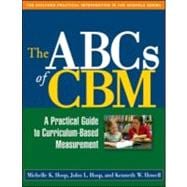This pragmatic, accessible book presents an empirically supported conceptual framework and hands-on instructions for conducting curriculum-based measurement (CBM) in grades K-8. The authors provide the tools needed to assess student learning in reading, spelling, writing, and math, and to graph the resulting data. The role of CBM in systematic instructional problem solving is explained. Every chapter includes helpful answers to frequently asked questions, and the appendices contain over 20 reproducible administration and scoring guides, forms, and planning checklists. The large-size format and lay-flat binding facilitate photocopying and day-to-day use.
See also The ABCs of Curriculum-Based Evaluation: A Practical Guide to Effective Decision Making, by John L. Hosp, Michelle K. Hosp, Kenneth W. Howell, and Randy Allison, which presents a broader problem-solving model that utilizes CBM.
See also The ABCs of Curriculum-Based Evaluation: A Practical Guide to Effective Decision Making, by John L. Hosp, Michelle K. Hosp, Kenneth W. Howell, and Randy Allison, which presents a broader problem-solving model that utilizes CBM.








